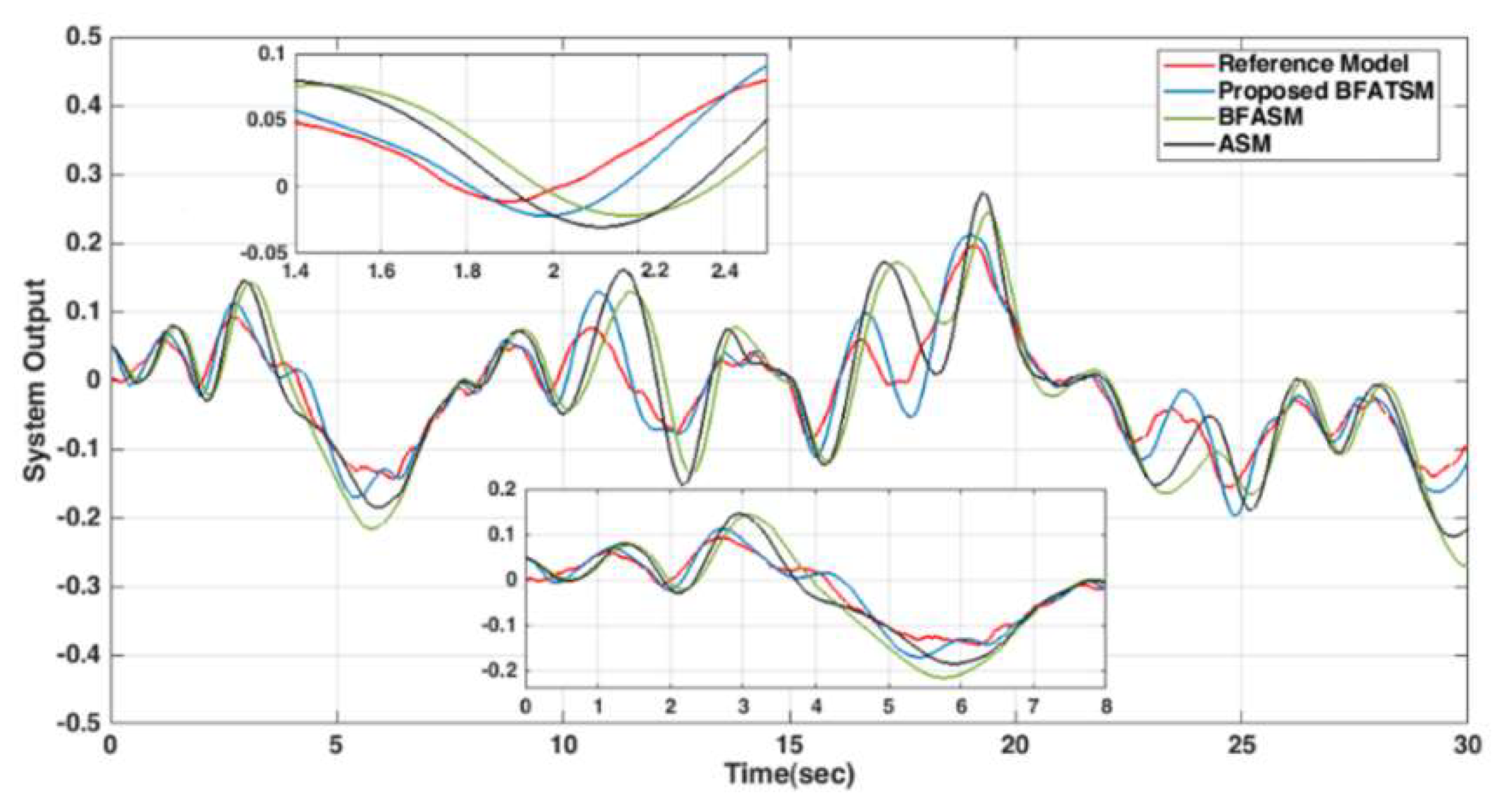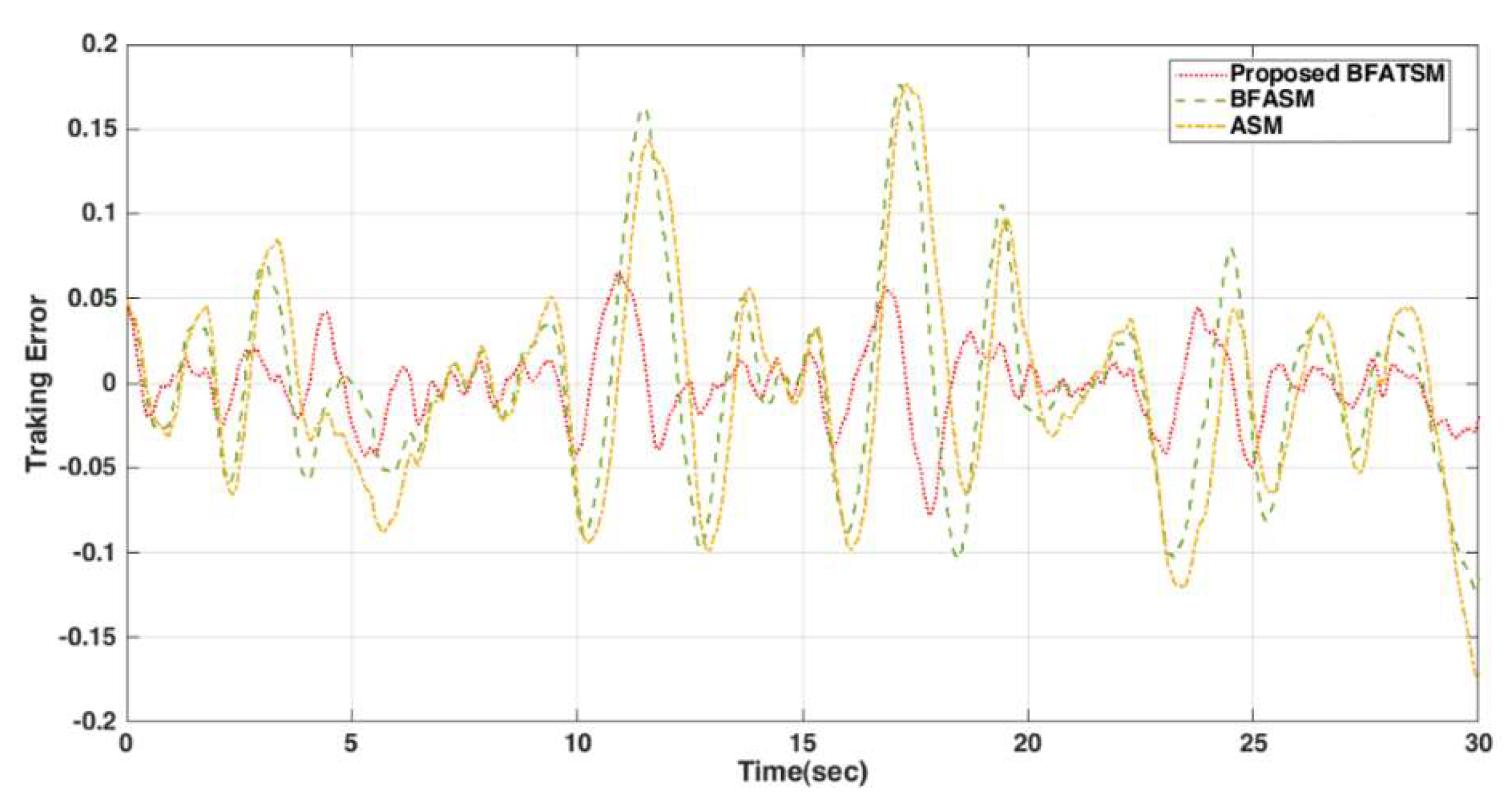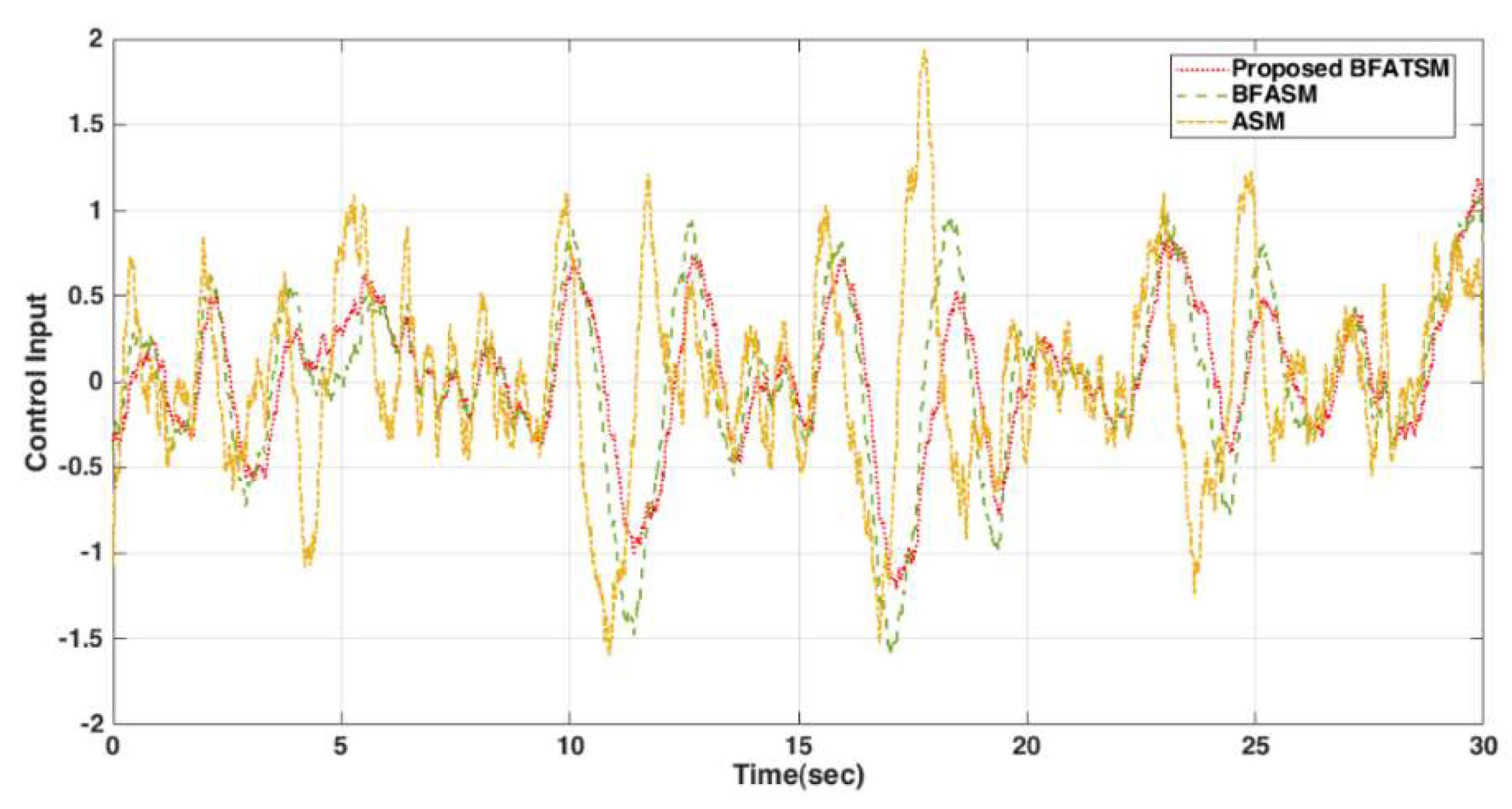Nonsingular Terminal Sliding Mode Control Based on Adaptive Barrier Function for nth-Order Perturbed Nonlinear Systems
Abstract
1. Introduction
2. System Definition
3. Main Results
3.1. BFATSM Control
3.2. New 3D Chaotic System
3.3. New 3D Chaotic System with External Disturbance and Uncertain Parameters
4. Main Results
4.1. BFATSM Controller
4.2. Chaos Synchronization
4.3. Control Parameters
- Parameters : Parameter c, as shown in Equation (6), is the coefficient of variation of the sliding surface. Larger c, means faster convergence of system modes. According to Equation (16), smaller means less absorption area for the sliding surface variable. If this parameter is selected too small, it may impose a larger control gain on the system. According to Equations (7) and (16), determines the size of the state convergence region and must be selected appropriately.
- Parameters : in the control laws (13) and (23), and can effectively increase the efficiency of the controller. If these two parameters are selected too large, it will increase the control gain too much, which will lead to chattering of the control signal.
- The control parameters in the simulation process are exposed in Table 2.
5. Conclusions
Author Contributions
Funding
Institutional Review Board Statement
Informed Consent Statement
Data Availability Statement
Acknowledgments
Conflicts of Interest
References
- Wang, S.; Gao, Y.; Liu, J.; Wu, L. Saturated sliding mode control with limited magnitude and rate. IET Control Theory Appl. 2018, 12, 1075–1085. [Google Scholar] [CrossRef]
- Yuan, X.; Chen, B.; Lin, C. Prescribed Finite-Time Adaptive Neural Tracking Control for Nonlinear State-Constrained Systems: Barrier Function Approach. IEEE Trans. Neural Netw. Learn. Syst. 2021. [Google Scholar] [CrossRef] [PubMed]
- Lin, C.-H.; Ho, C.-W.; Hu, G.-H.; Sreeramaneni, B.; Yan, J.-J. Secure Data Transmission Based on Adaptive Chattering-Free Sliding Mode Synchronization of Unified Chaotic Systems. Mathematics 2021, 9, 2658. [Google Scholar] [CrossRef]
- Kaur, R.P.; Sharma, A.; Sharma, A.K.; Sahu, G.P. Chaos control of chaotic plankton dynamics in the presence of additional food, seasonality, and time delay. Chaos Solitons Fractals 2021, 153, 111521. [Google Scholar] [CrossRef]
- Rahman, Z.-A.S.A.; Jasim, B.H.; Al-Yasir, Y.I.A.; Hu, Y.-F.; Abd-Alhameed, R.A.; Alhasnawi, B.N. A New Fractional-Order Chaotic System with Its Analysis, Synchronization, and Circuit Realization for Secure Communication Applications. Mathematics 2021, 9, 2593. [Google Scholar] [CrossRef]
- Sajan; Dubey, B. Chaos control in a multiple delayed phytoplankton–zooplankton model with group defense and predator’s interference. Chaos Interdiscip. J. Nonlinear Sci. 2021, 31, 083101. [Google Scholar] [CrossRef]
- Dousseh, P.Y.; Ainamon, C.; Miwadinou, C.H.; Monwanou, A.V.; Chabi Orou, J.B. Chaos in a financial system with fractional order and its control via sliding mode. Complexity 2021, 2021, 4636658. [Google Scholar] [CrossRef]
- Hu, T.; Teel, A.R.; Zaccarian, L. Regional anti-windup compensation for linear systems with input saturation. In Proceedings of the 2005, American Control Conference, Portland, OR, USA, 8–10 June 2005; pp. 3397–3402. [Google Scholar]
- Chen, M.; Tao, G.; Jiang, B. Dynamic surface control using neural networks for a class of uncertain nonlinear systems with input saturation. IEEE Trans. Neural Netw. Learn. Syst. 2014, 26, 2086–2097. [Google Scholar] [CrossRef]
- Min, H.; Xu, S.; Ma, Q.; Zhang, B.; Zhang, Z. Composite-observer-based output-feedback control for nonlinear time-delay systems with input saturation and its application. IEEE Trans. Ind. Electron. 2017, 65, 5856–5863. [Google Scholar] [CrossRef]
- Gao, S.; Ning, B.; Dong, H. Fuzzy dynamic surface control for uncertain nonlinear systems under input saturation via truncated adaptation approach. Fuzzy Sets Syst. 2016, 290, 100–117. [Google Scholar] [CrossRef]
- Ding, S.; Zheng, W.X. Nonsingular terminal sliding mode control of nonlinear second-order systems with input saturation. Int. J. Robust Nonlinear Control 2016, 26, 1857–1872. [Google Scholar] [CrossRef]
- Moysis, L.; Petavratzis, E.; Marwan, M.; Volos, C.; Nistazakis, H.; Ahmad, S. Analysis, synchronization, and robotic application of a modified hyperjerk chaotic system. Complexity 2020, 2020, 2826850. [Google Scholar] [CrossRef]
- Azizi, T.; Kerr, G. Chaos synchronization in discrete-time dynamical systems with application in population dynamics. J. Appl. Math. Phys. 2020, 8, 406–423. [Google Scholar] [CrossRef][Green Version]
- Vaseghi, B.; Pourmina, M.A.; Mobayen, S. Finite-time chaos synchronization and its application in wireless sensor networks. Trans. Inst. Meas. Control. 2018, 40, 3788–3799. [Google Scholar] [CrossRef]
- Huang, Y.; Huang, L.; Wang, Y.; Peng, Y.; Yu, F. Shape synchronization in driver-response of 4-D chaotic system and its application in image encryption. IEEE Access 2020, 8, 135308–135319. [Google Scholar] [CrossRef]
- Azar, A.T.; Serrano, F.E.; Kamal, N.A.; Koubaa, A. Robust kinematic control of unmanned aerial vehicles with non-holonomic constraints. In Proceedings of the International Conference on Advanced Intelligent Systems and Informatics, Cairo, Egypt, 19–21 October 2020; pp. 839–850. [Google Scholar]
- Benkouider, K.; Bouden, T.; Yalcin, M.E. A snail-shaped chaotic system with large bandwidth: Dynamical analysis, synchronization and secure communication scheme. SN Appl. Sci. 2020, 2, 1–15. [Google Scholar] [CrossRef]
- Sambas, A.; Mamat, M.; Arafa, A.A.; Mahmoud, G.M.; Mohamed, M.A.; Sanjaya, W. A new chaotic system with line of equilibria: Dynamics, passive control and circuit design. Int. J. Electr. Comput. Eng. (2088-8708) 2019, 9, 2365–2376. [Google Scholar] [CrossRef]
- Zheng, W.; Zhang, G. Control and synchronization of a new class of finance chaotic systems. In Proceedings of the 2019 Chinese Control And Decision Conference (CCDC), Nanchang, China, 3–5 June 2019; pp. 200–205. [Google Scholar]
- Cruz-Ancona, C.D.; Estrada, M.A.; Fridman, L. Barrier Function-Based Adaptive Lyapunov Redesign for Systems without a priori Bounded Perturbations. IEEE Trans. Autom. Control 2021. [Google Scholar] [CrossRef]
- Roy, S.; Baldi, S.; Fridman, L.M. On adaptive sliding mode control without a priori bounded uncertainty. Automatica 2020, 111, 108650. [Google Scholar] [CrossRef]
- Rodrigues, V.H.P.; Hsu, L.; Oliveira, T.R.; Fridman, L. Adaptive sliding mode control with guaranteed performance based on monitoring and barrier functions. Int. J. Adapt. Control. Signal Processing 2021. [Google Scholar] [CrossRef]
- Shao, K.; Zheng, J.; Wang, H.; Wang, X.; Lu, R.; Man, Z. Tracking control of a linear motor positioner based on barrier function adaptive sliding mode. IEEE Trans. Ind. Inform. 2021, 17, 7479–7488. [Google Scholar] [CrossRef]
- Armghan, A.; Hassan, M.; Armghan, H.; Yang, M.; Alenezi, F.; Azeem, M.K.; Ali, N. Barrier Function Based Adaptive Sliding Mode Controller for a Hybrid AC/DC Microgrid Involving Multiple Renewables. Appl. Sci. 2021, 11, 8672. [Google Scholar] [CrossRef]
- Liu, Z.; Pan, H. Barrier Function-Based Adaptive Sliding-Mode Control for Application to Vehicle Suspension. IEEE Trans. Transp. Electrif. 2020, 7, 2023–2033. [Google Scholar] [CrossRef]
- Laghrouche, S.; Harmouche, M.; Chitour, Y.; Obeid, H.; Fridman, L.M. Barrier function-based adaptive higher order sliding mode controllers. Automatica 2021, 123, 109355. [Google Scholar] [CrossRef]
- Mobayen, S.; Alattas, K.A.; Assawinchaichote, W. Adaptive continuous barrier function terminal sliding mode control technique for disturbed robotic manipulator. IEEE Trans. Circuits Syst. I Regul. Pap. 2021, 68, 4403–4412. [Google Scholar] [CrossRef]
- Obeid, H.; Fridman, L.M.; Laghrouche, S.; Harmouche, M. Barrier function-based adaptive sliding mode control. Automatica 2018, 93, 540–544. [Google Scholar] [CrossRef]
- Gan, W.S. Techniques in the application of chaos theory in signal and image processing. In Control and Dynamic Systems; Elsevier: Amsterdam, The Netherlands, 1996; Volume 77, pp. 339–387. [Google Scholar]
- Frederickson, P.; Kaplan, J.L.; Yorke, E.D.; Yorke, J.A. The Liapunov dimension of strange attractors. J. Differ. Equ. 1983, 49, 185–207. [Google Scholar] [CrossRef]
- Singh, J.P.; Roy, B.K. A more chaotic and easily hardware implementable new 3-D chaotic system in comparison with 50 reported systems. Nonlinear Dyn. 2018, 93, 1121–1148. [Google Scholar] [CrossRef]
- Kapitaniak, T.; Mohammadi, S.A.; Mekhilef, S.; Alsaadi, F.E.; Hayat, T.; Pham, V.-T. A new chaotic system with stable equilibrium: Entropy analysis, parameter estimation, and circuit design. Entropy 2018, 20, 670. [Google Scholar] [CrossRef] [PubMed]
- Yang, Q.; Qiao, X. Constructing a new 3D chaotic system with any number of equilibria. Int. J. Bifurc. Chaos 2019, 29, 1950060. [Google Scholar] [CrossRef]
- Jinjie, H.; Guangming, S. A new chaotic system and its synchronization with phase spatial rotation. In Proceedings of the 2018 Chinese Control And Decision Conference (CCDC), Shenyang, China, 9–11 June 2018; pp. 193–196. [Google Scholar]
- Yanmin, L.; Fuhong, M.; Chuang, L.; Biaoming, Y. A new four-dimensional four-wing chaotic circuit based on Qi chaotic system. In Proceedings of the 2018 37th Chinese Control Conference (CCC), Wuhan, China, 25–27 July 2018; pp. 743–748. [Google Scholar]
- Lassoued, A.; Boubaker, O.; Dhifaoui, R.; Jafari, S. Experimental observations and circuit realization of a jerk chaotic system with piecewise nonlinear function. In Recent Advances in Chaotic Systems and Synchronization; Elsevier: Amsterdam, The Netherlands, 2019; pp. 3–21. [Google Scholar]
- Mobayen, S.; Kingni, S.T.; Pham, V.-T.; Nazarimehr, F.; Jafari, S. Analysis, synchronisation and circuit design of a new highly nonlinear chaotic system. Int. J. Syst. Sci. 2018, 49, 617–630. [Google Scholar] [CrossRef]
- Sahin, M.E.; Taskiran, Z.G.C.; Guler, H.; Hamamci, S.E. Application and modeling of a novel 4D memristive chaotic system for communication systems. Circuits Syst. Signal Processing 2020, 39, 3320–3349. [Google Scholar] [CrossRef]
- Lien, C.; Vaidyanathan, S.; Sambas, A.; Sampath, S.; Mamat, M. A new 3-D chaotic system with four quadratic nonlinear terms, its global chaos control via passive control method and circuit design. In Proceedings of the IOP Conference Series: Materials Science and Engineering, Bali, Indonesia, 30–31 August 2018; p. 012013. [Google Scholar]
- Xu, G.; Shekofteh, Y.; Akgül, A.; Li, C.; Panahi, S. A new chaotic system with a self-excited attractor: Entropy measurement, signal encryption, and parameter estimation. Entropy 2018, 20, 86. [Google Scholar] [CrossRef] [PubMed]
- Vaidyanathan, S.; Abba, O.A.; Betchewe, G.; Alidou, M. A new three-dimensional chaotic system: Its adaptive control and circuit design. Int. J. Autom. Control 2019, 13, 101–121. [Google Scholar] [CrossRef]
- Idowu, B.A.; Vaidyanathan, S.; Sambas, A.; Olusola, O.I.; Onma, O. A.; Vaidyanathan, S.; Sambas, A.; Olusola, O.I.; Onma, O. A new chaotic finance system: Its analysis, control, synchronization and circuit design. In Nonlinear Dynamical Systems with Self-Excited and Hidden Attractors; Springer: Berlin/Heidelberg, Germany, 2018; pp. 271–295. [Google Scholar]


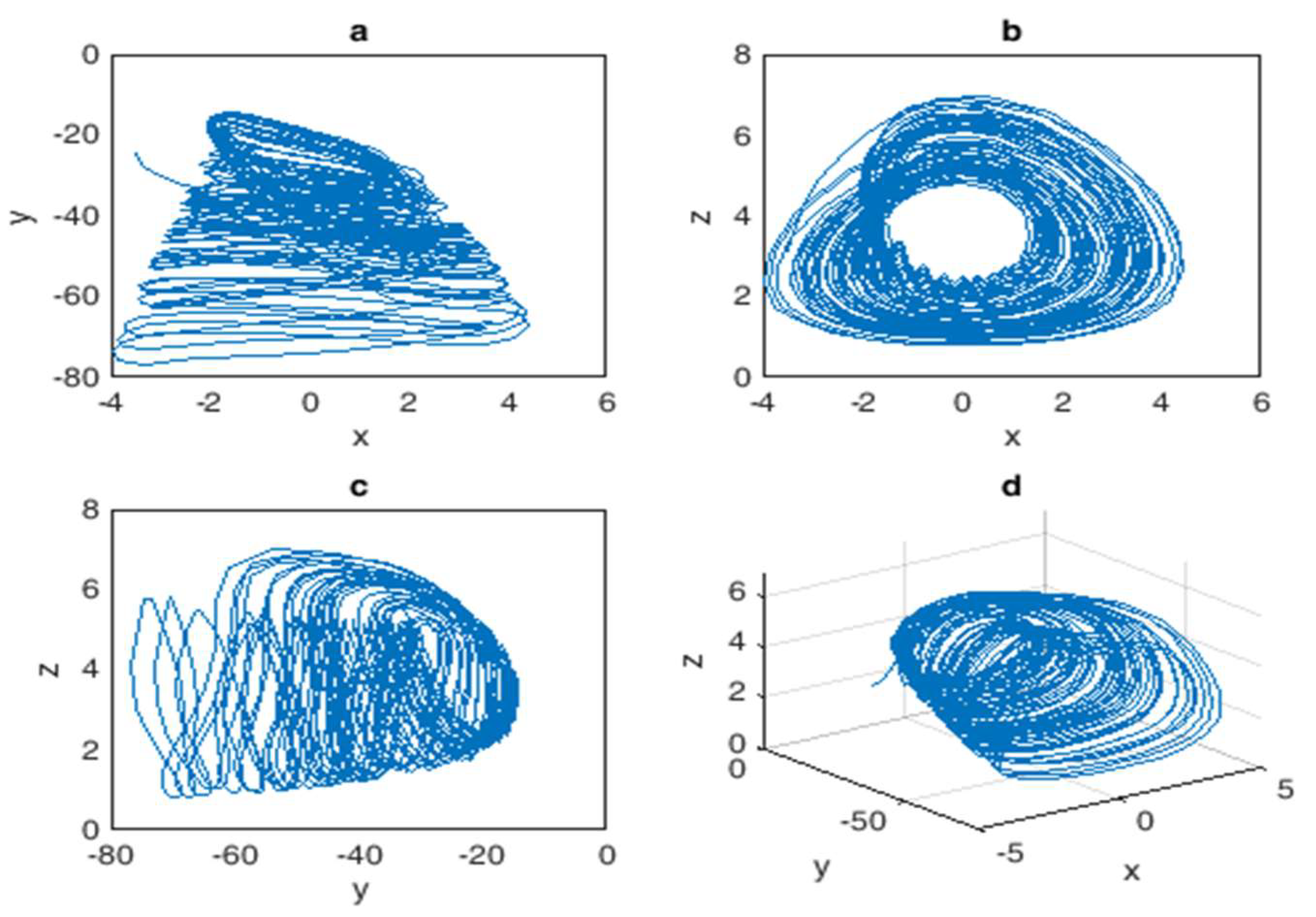
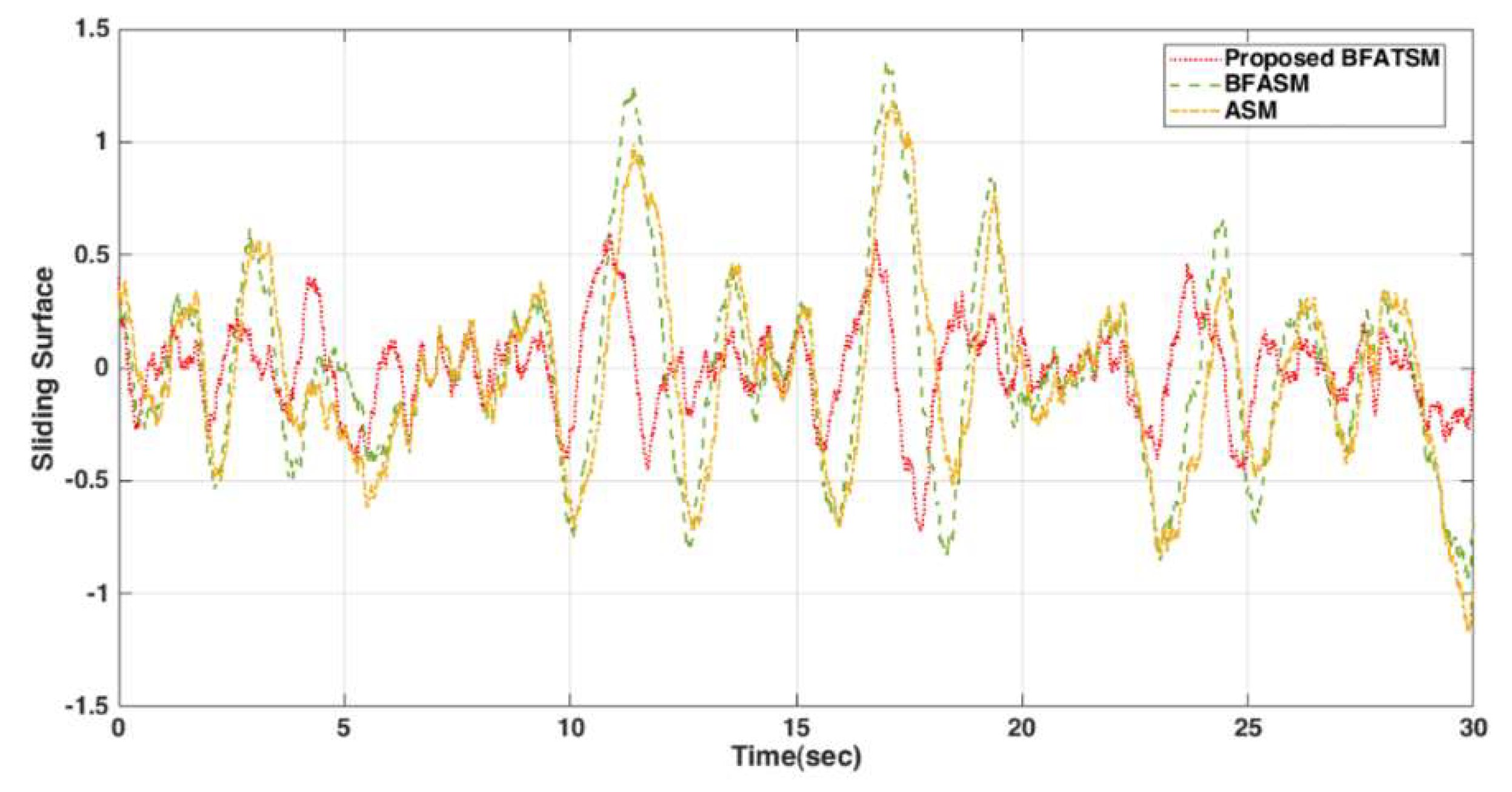
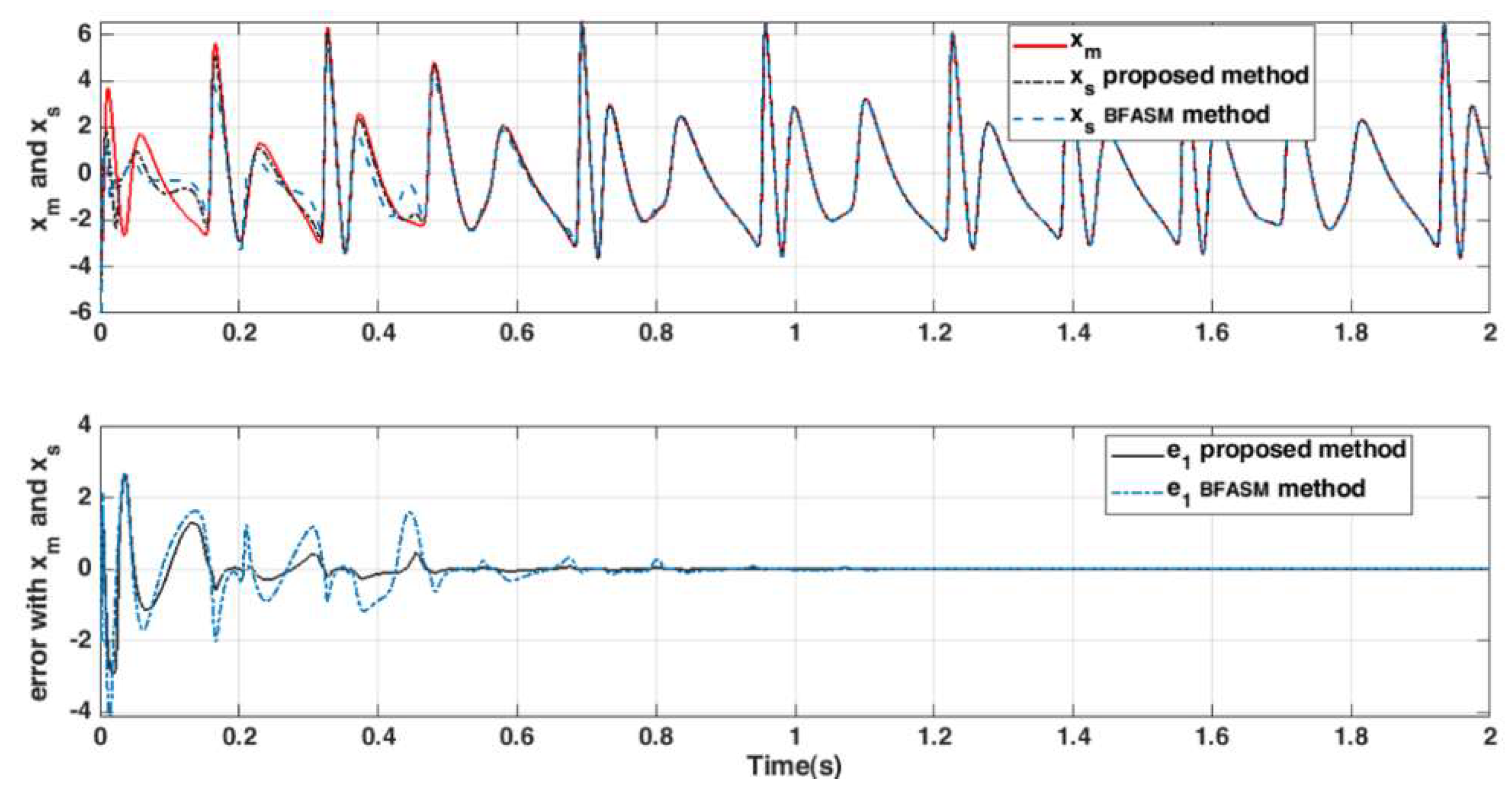
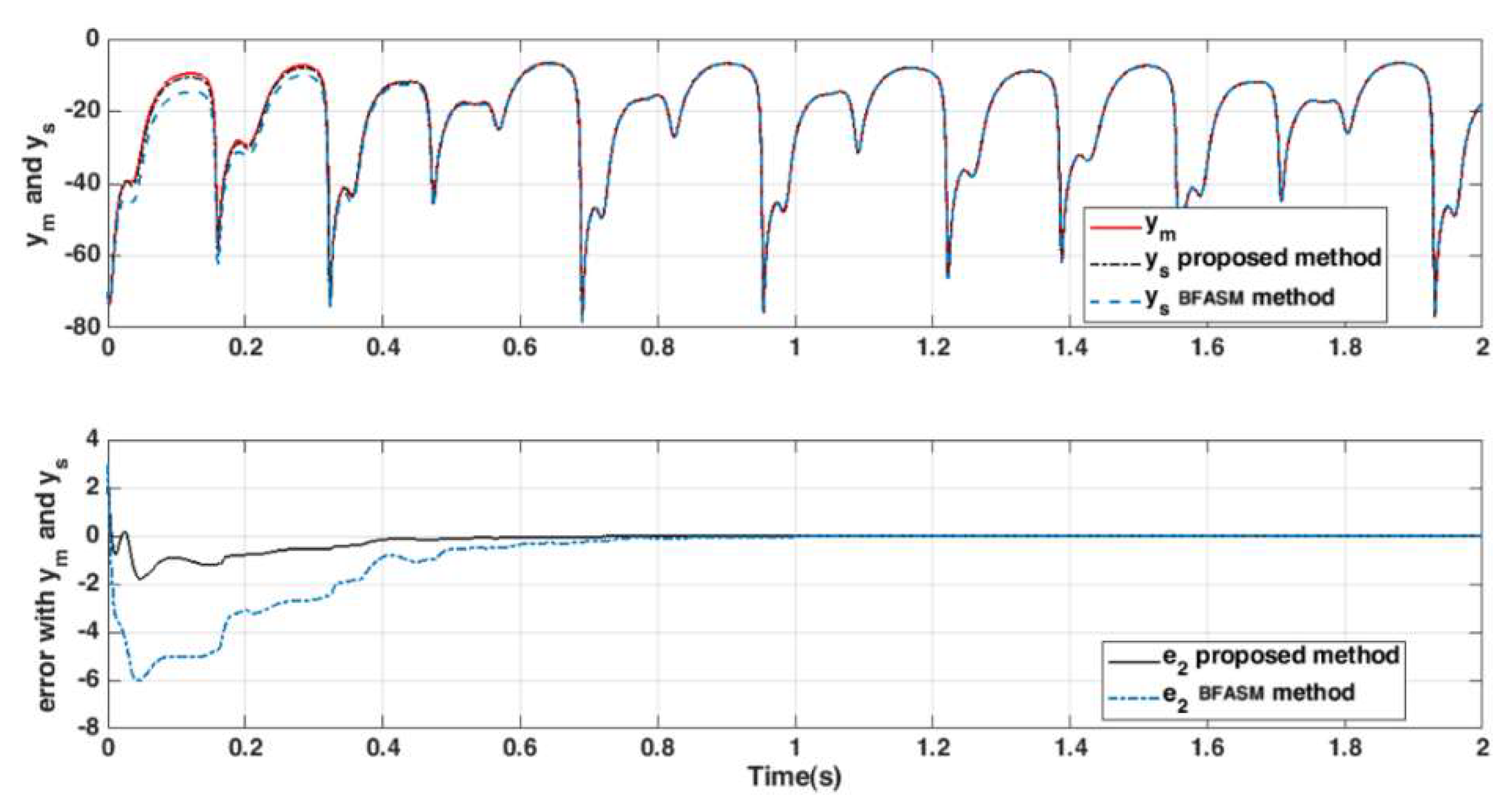
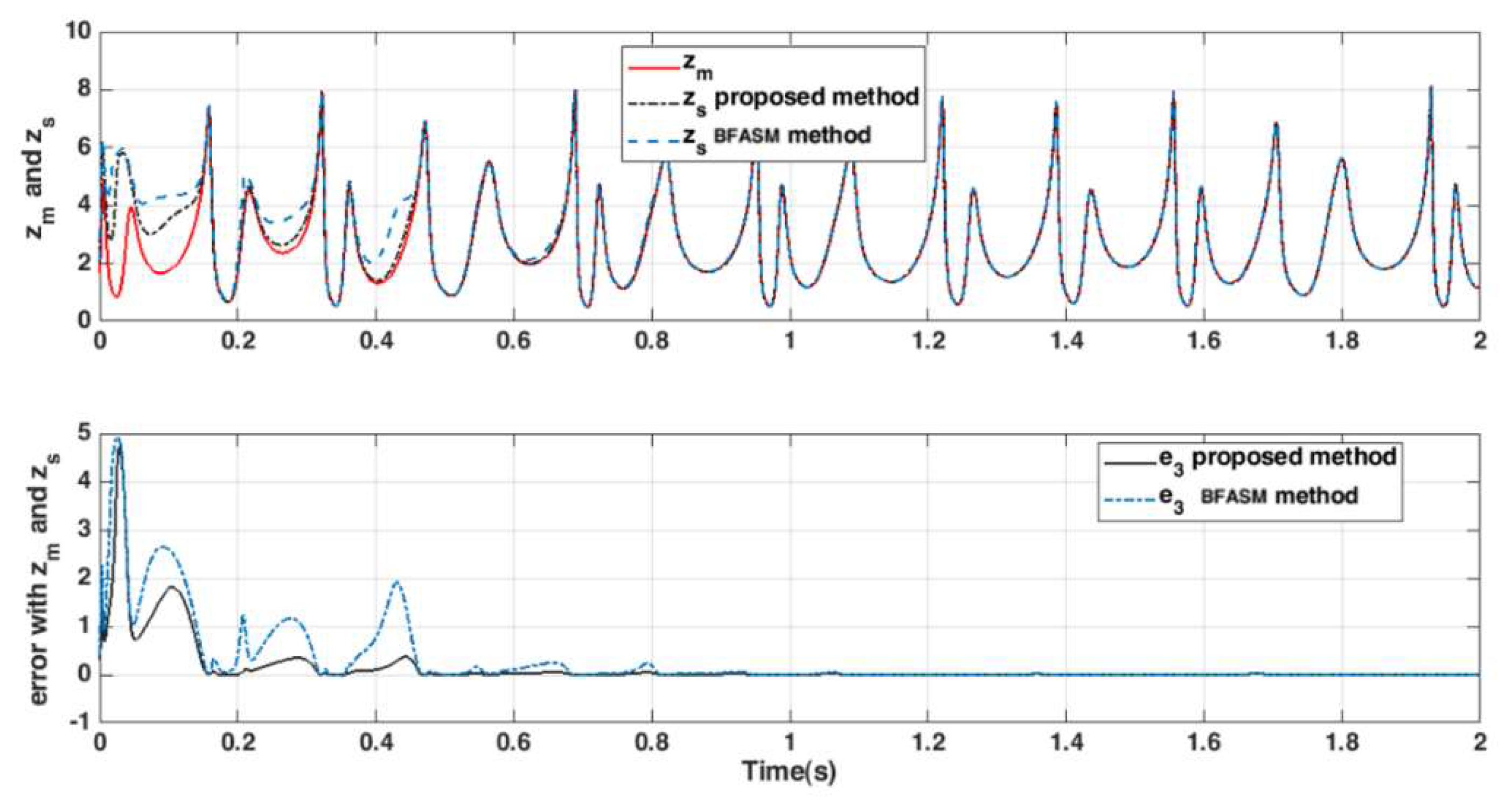
| No. | System | KYD | No. | System | KYD |
|---|---|---|---|---|---|
| 1 | Singh and Roy [32] | 2.16 | 9 | Kapitaniak et al. [33] | 2.107 |
| 2 | Yang and Qiao [34] | 2.112 | 10 | Zheng and Zhang [20] | 2.594 |
| 3 | Jinjie and Guangming [35] | 2.185 | 11 | Yanmin et al. [36] | 2.276 |
| 4 | Lassoued et al. [37] | 2.124 | 12 | Mobayen et al. [38] | 2.367 |
| 5 | Sahin et al. [39] | 2.579 | 13 | Benkouider et al. [18] | 2.652 |
| 6 | Lien et al. [40] | 2.163 | 14 | Xu et al. [41] | 2.074 |
| 7 | Vaidyanathan et al. [42] | 2.162 | 15 | System (33) | 2.661 |
| 8 | Idowu et al. [43] | 2.263 |
| Parameters | Values | Parameters | Values |
|---|---|---|---|
| 12.5 | 0.033 | ||
| 0.61 | c | 114 | |
| 9.3 | 0.17 | ||
| r | 19 | 11 | |
| q | 3 | b | 1 |
Publisher’s Note: MDPI stays neutral with regard to jurisdictional claims in published maps and institutional affiliations. |
© 2021 by the authors. Licensee MDPI, Basel, Switzerland. This article is an open access article distributed under the terms and conditions of the Creative Commons Attribution (CC BY) license (https://creativecommons.org/licenses/by/4.0/).
Share and Cite
Alattas, K.A.; Mostafaee, J.; Alanazi, A.K.; Mobayen, S.; Vu, M.T.; Zhilenkov, A.; Abo-Dief, H.M. Nonsingular Terminal Sliding Mode Control Based on Adaptive Barrier Function for nth-Order Perturbed Nonlinear Systems. Mathematics 2022, 10, 43. https://doi.org/10.3390/math10010043
Alattas KA, Mostafaee J, Alanazi AK, Mobayen S, Vu MT, Zhilenkov A, Abo-Dief HM. Nonsingular Terminal Sliding Mode Control Based on Adaptive Barrier Function for nth-Order Perturbed Nonlinear Systems. Mathematics. 2022; 10(1):43. https://doi.org/10.3390/math10010043
Chicago/Turabian StyleAlattas, Khalid A., Javad Mostafaee, Abdullah K. Alanazi, Saleh Mobayen, Mai The Vu, Anton Zhilenkov, and Hala M. Abo-Dief. 2022. "Nonsingular Terminal Sliding Mode Control Based on Adaptive Barrier Function for nth-Order Perturbed Nonlinear Systems" Mathematics 10, no. 1: 43. https://doi.org/10.3390/math10010043
APA StyleAlattas, K. A., Mostafaee, J., Alanazi, A. K., Mobayen, S., Vu, M. T., Zhilenkov, A., & Abo-Dief, H. M. (2022). Nonsingular Terminal Sliding Mode Control Based on Adaptive Barrier Function for nth-Order Perturbed Nonlinear Systems. Mathematics, 10(1), 43. https://doi.org/10.3390/math10010043








